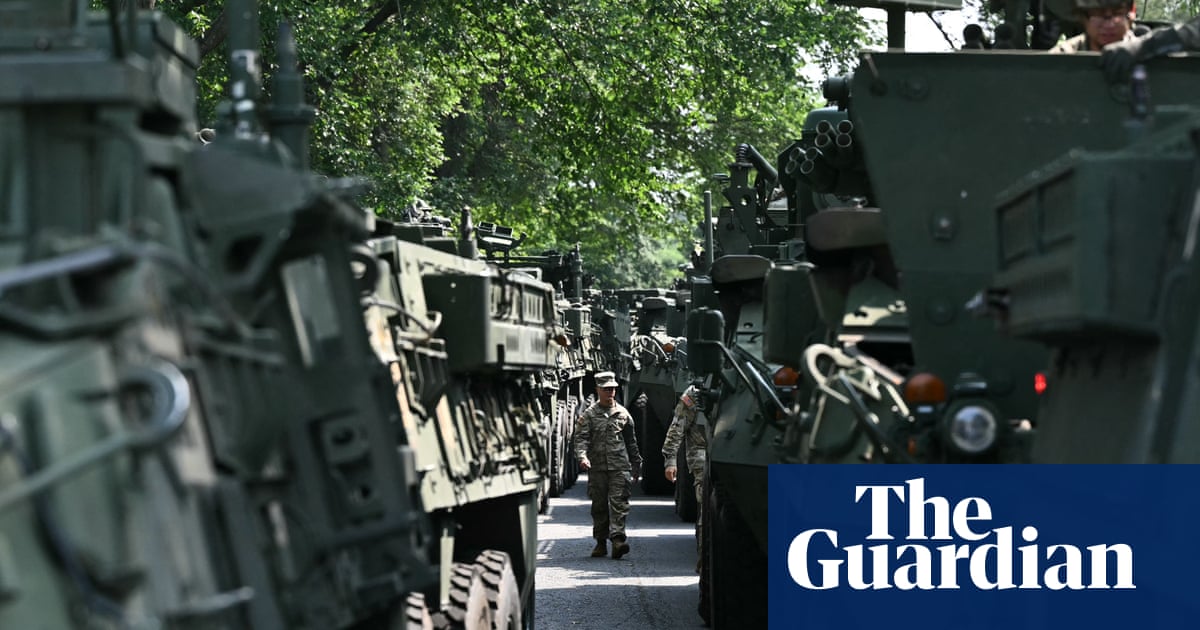Donald Trump’s military parade this weekend will bring thousands of troops out to march, while dozens of tanks and armored personnel carriers roll down the streets and fighter jets hum overhead.
The event has promptedconcernabout rising autocracy in the US. It will also produce more than 2m kilograms of planet-heatingpollution– equivalent to the amount created by producing of 67m plastic bags or by the energy used to power about300 homes in one year, according to a review by the progressive thinktank Institute for Policy Studies and the Guardian.
Themilitary paradeis meant to celebrate the US army’s 250th anniversary on 14 June – which will also coincide with the president’s 79th birthday. Itwill feature150 military vehicles including 60-ton tanks and armored fighting vehicles, and more than 50 helicopters and aircraft such as a Mustang fighter aircraft and a B-25 Mitchell bomber, which were both used widely during the second world war. These vehicles burn dozens or even hundreds of gallons of fuel per hour.
Institute for Policy studies quantified the emissions that will result from the use of those vehicles, using data from the International Energy Agency and publicly available information. The researchers calculated emissions from not only the parade route itself, but also the transport of the vehicles to the event and the upstream impact of producing fuel for the parade.
The large quantity of emissions this activity is estimated to produce is equivalent to those from flying 4,700 people from North Carolina – where the parade helicopters are based – to the nation’s capital in first class.
The calculation is probably an understatement as it does not include pollution from transporting thousands of people, horses and equipment to the parade, or other energy used for the event.
Hanna Homestead, research analyst at the Institute for Policy Studies, noted the same kinds of vehicles deployed for the parade have also been used to transport napalm and other supplies to Vietnam, and are now being used by Israel in its siege on Gaza.
“So we’re spending money to glorify a gas-guzzling equipment used for war, genocide and planetary destruction,” she said, “at the same time as critical services for populations at home and around the world are being slashed.”
Reached for comment, a White House spokesperson, Anna Kelley, said the parade “will honor all of the military men and women who have bravely served our country, including those who made the ultimate sacrifice to defend our freedom”.
The president reportedly sought to throw a similar tribute during his first term, inspired by Bastille Day celebrations in France, but was thwarted by the then secretary of defense, James Mattis. Trump’s parade this year has inspired“No Kings”protestsacross the country.
Sign up toThis Week in Trumpland
A deep dive into the policies, controversies and oddities surrounding the Trump administration
after newsletter promotion
Lindsay Koshgarian, program director at the Institute for Policy Studies, said that the parade’s emissions were “egregious” and the event itself was a “wake-up call” about Trump’s priorities.
“This parade comes alongside proposals for a $1tn Pentagon budget, along with massive cuts to healthcare, food programs, and an ideological attack on climate programs both in the Pentagon and across government,” she said. “The more we spend on sending these fuel-guzzling tanks and helicopters around the world, the less we have to protect our people, communities and the planet.”
The Institute for Policy Studies’ National Priorities Project, which focuses on budget analysis and which Koshgarian directs, found that the $45m it will cost to hold the military paradewould be enoughto fund programs Trump has put on the chopping block, such as the two offices enforcing endangered species protection or the development of an HIV vaccine in South Africa.
Military forces’ contribution to global carbon emissions has come under greaterscrutinyin recent years. The world’s militaries produce at least 5.5% of greenhouse gas emissions – more than the total footprint of Japan – one 2022estimatefound. And the US Department of Defense is thesingle largest institutional greenhouse gas emitterin the world, usingmore petroleum than any other institution, research shows.
